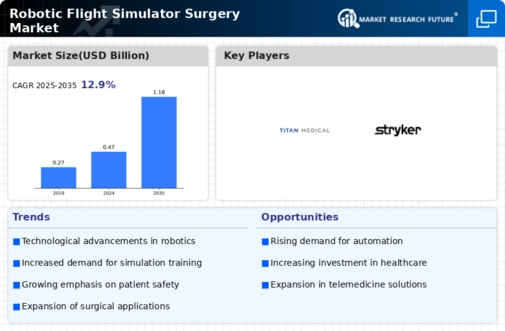-
Definition
-
Scope of the Study
- Research Objective
- Assumptions
- Limitations
-
Introduction
-
Primary Research
-
Secondary research
-
Market Size Estimation
-
Drivers
-
Restraints
-
Opportunities
-
Challenges
-
Macroeconomic Indicators
-
Technology Trends & Assessment
-
Porter’s Five Forces Analysis
- Bargaining Power of Suppliers
- Bargaining Power of Buyers
- Threat of New Entrants
- Threat of Substitutes
- Intensity of Rivalry
-
Value Chain Analysis
-
Investment Feasibility Analysis
-
Pricing Analysis
-
Chapter 6. Global Robotic Flight Simulator Surgery Market, by Application
-
Introduction
-
General Surgery
-
Market Estimates & Forecast, 2017–2023
-
Cardiology Surgery
-
Market Estimates & Forecast, 2017–2023
-
Neurosurgery
-
Market Estimates & Forecast, 2017–2023
-
Gynecology
-
Market Estimates & Forecast, 2017–2023
-
Others
-
Chapter 7. Global Robotic Flight Simulator Surgery Market, by Method
-
Introduction
-
Direct Tele Manipulator
-
Market Estimates & Forecast, 2017–2023
-
Computer Control
-
Market Estimates & Forecast, 2017–2023
-
Others
-
Chapter 8. Global Robotic Flight Simulator Surgery Market, by End-User
-
Introduction
-
Hospitals
-
Market Estimates & Forecast, 2017–2023
-
Clinics
-
Market Estimates & Forecast, 2017–2023
-
Ambulatory Surgical Centers
-
Market Estimates & Forecast, 2017–2023
-
Others
-
Chapter 9. Global Robotic Flight Simulator Surgery Market, by Region
-
Introduction
-
America
- North America
- South America
-
Europe
- Western Europe
- Eastern Europe
-
Asia Pacific
- Japan
- China
- India
- Australia
- Republic of Korea
- Rest of Asia Pacific
-
The Middle East & Africa
- United Arab Emirates
- Saudi Arabia
- Oman
- Kuwait
- Qatar
- Rest of the Middle East & Africa
-
Chapter 10. Company Landscape
-
Introduction
-
Market Share Analysis
-
Key Development & Strategies
- Key Developments
-
Chapter 11 Company Profiles
-
Intuitive Surgical
- Company Overview
- Application Overview
- Financials
- Key Developments
- SWOT Analysis
-
TransEnterix
- Company Overview
- Application Overview
- Financial Overview
- Key Developments
- SWOT Analysis
-
Titan Medical
- Company Overview
- Application Overview
- Financial Overview
- Key Development
- SWOT Analysis
-
Virtualincision
- Company Overview
- Application/Business Segment Overview
- Financial Overview
- Key Development
- SWOT Analysis
-
AVRA
- Company Overview
- Application Overview
- Financial overview
- Key Developments
- SWOT Analysis
-
Hansen Medical
- Company Overview
- Application Overview
- Financial Overview
- Key Developments
- SWOT Analysis
-
Corindus Vascular Robots
- Overview
- Application Overview
- Financials
- Key Developments
- SWOT Analysis
-
Interventional Systems
- Overview
- Application Overview
- Financials
- Key Developments
- SWOT Analysis
-
Stryker
- Overview
- Application Overview
- Financials
- Key Developments
- SWOT Analysis
-
Mazor Robotics
- Overview
- Application Overview
- Financials
- Key Developments
- SWOT Analysis
-
Others
-
Chapter 12 MRFR Conclusion
-
Key Findings
- From CEO’s View Point
- Unmet Needs of the Market
-
Key Companies to Watch
-
Prediction of Global Robotic Flight Simulator Surgery Market
-
Chapter 13 Appendix
-
-
LIST OF TABLES
-
Global Robotic Flight Simulator Surgery Market Industry Synopsis, 2017–2023
-
Global Robotic Flight Simulator Surgery Market Estimates & Forecast, 2017–2023, (USD Million)
-
Global Robotic Flight Simulator Surgery Market, by Region, 2017–2023, (USD Million)
-
Global Robotic Flight Simulator Surgery Market, by Application, 2017–2023, (USD Million)
-
Global Robotic Flight Simulator Surgery Market, by Method, 2017–2023, (USD Million)
-
Global Robotic Flight Simulator Surgery Market, by End-User, 2017–2023, (USD Million
-
North America Global Robotic Flight Simulator Surgery Market, by Application, 2017–2023, (USD Million)
-
North America Global Robotic Flight Simulator Surgery Market, by Method, 2017–2023, (USD Million)
-
North America Global Robotic Flight Simulator Surgery Market, by End-User, 2017–2023, (USD Million)
-
U.S. Global Robotic Flight Simulator Surgery Market, by Application, 2017–2023, (USD Million)
-
U.S. Global Robotic Flight Simulator Surgery Market, by Method, 2017–2023, (USD Million)
-
U.S. Global Robotic Flight Simulator Surgery Market, by End-User, 2017–2023, (USD Million)
-
Canada Global Robotic Flight Simulator Surgery Market, by Application, 2017–2023, (USD Million)
-
Canada Global Robotic Flight Simulator Surgery Market, by Method, 2017–2023, (USD Million)
-
Canada Global Robotic Flight Simulator Surgery Market, by End-User, 2017–2023, (USD Million)
-
South America Global Robotic Flight Simulator Surgery Market, by Application, 2017–2023, (USD Million)
-
South America Global Robotic Flight Simulator Surgery Market, by Method, 2017–2023, (USD Million)
-
South America Global Robotic Flight Simulator Surgery Market, by End-User, 2017–2023, (USD Million)
-
Europe Global Robotic Flight Simulator Surgery Market, by Application, 2017–2023, (USD Million)
-
Europe Global Robotic Flight Simulator Surgery Market, by Method, 2017–2023, (USD Million)
-
Europe Global Robotic Flight Simulator Surgery Market, by End-User, 2017–2023, (USD Million)
-
Western Europe Global Robotic Flight Simulator Surgery Market, by Application, 2017–2023, (USD Million)
-
Western Europe Global Robotic Flight Simulator Surgery Market, by Method, 2017–2023, (USD Million)
-
Western Europe Global Robotic Flight Simulator Surgery Market, by End-User, 2017–2023, (USD Million)
-
Eastern Europe Global Robotic Flight Simulator Surgery Market, by Application, 2017–2023, (USD Million)
-
Eastern Europe Global Robotic Flight Simulator Surgery Market, by Method, 2017–2023, (USD Million)
-
Eastern Europe Global Robotic Flight Simulator Surgery Market by End-User, 2017–2023, (USD Million)
-
Asia Pacific Global Robotic Flight Simulator Surgery Market, by Application, 2017–2023, (USD Million)
-
Asia Pacific Global Robotic Flight Simulator Surgery Market, by Method, 2017–2023, (USD Million)
-
Asia Pacific Global Robotic Flight Simulator Surgery Market, by End-User, 2017–2023, (USD Million)
-
The Middle East & Africa Global Robotic Flight Simulator Surgery Market, by Application, 2017–2023, (USD Million)
-
The Middle East & Africa Global Robotic Flight Simulator Surgery Market, by Method, 2017–2023, (USD Million)
-
The Middle East & Africa Global Robotic Flight Simulator Surgery Market, by End-User, 2017–2023, (USD Million)
-
LIST OF FIGURES
-
Research Process
-
Segmentation for Global Robotic Flight Simulator Surgery Market
-
Market Dynamics for Global Robotic Flight Simulator Surgery Market
-
Global Robotic Flight Simulator Surgery Market Share, by Application 2016
-
Global Robotic Flight Simulator Surgery Market Share, by Methods 2016
-
Global Robotic Flight Simulator Surgery Market Share, by End-User, 2016
-
Global Robotic Flight Simulator Surgery Market Share, by Region, 2016
-
North America Global Robotic Flight Simulator Surgery Market Share, by Country, 2016
-
Europe Global Robotic Flight Simulator Surgery Market Share, by Country, 2016
-
Asia Pacific Global Robotic Flight Simulator Surgery Market Share, by Country, 2016
-
The Middle East & Africa Global Robotic Flight Simulator Surgery Market Share, by Country, 2016
-
Global Robotic Flight Simulator Surgery Market: Company Share Analysis, 2016 (%)
-
Intuitive Surgical: Key Financials
-
Intuitive Surgical: Segmental Revenue
-
Intuitive Surgical: Geographical Revenue
-
TransEnterix: Key Financials
-
TransEnterix: Segmental Revenue
-
TransEnterix: Geographical Revenue
-
Titan Medical: Key Financials
-
Titan Medical: Segmental Revenue
-
Titan Medical: Geographical Revenue
-
Virtualincision: Key Financials
-
Virtualincision: Segmental Revenue
-
Virtualincision: Geographical Revenue
-
AVRA: Key Financials
-
AVRA: Segmental Revenue
-
AVRA: Geographical Revenue
-
Hansen Medical: Key Financials
-
Hansen Medical: Segmental Revenue
-
Hansen Medical: Geographical Revenue
-
Corindus Vascular Robots: Key Financials
-
Corindus Vascular Robots: Segmental Revenue
-
Corindus Vascular Robots: Geographical Revenue
-
Interventional Systems: Key Financials
-
Interventional Systems: Segmental Revenue
-
Interventional Systems: Geographical Revenue
-
Stryker: Key Financials
-
Stryker: Segmental Revenue
-
Stryker: Geographical Revenue
-
Mazor Robotics: Key Financials
-
Mazor Robotics: Segmental Revenue
-
Mazor Robotics: Geographical Revenue
-
"

















Leave a Comment